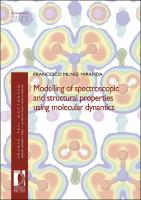Modelling of spectroscopic and structural properties using molecular dynamics
| dc.contributor.author | MUNIZ-MIRANDA, Francesco | |
| dc.date.accessioned | 2022-05-31T10:22:30Z | |
| dc.date.available | 2022-05-31T10:22:30Z | |
| dc.date.issued | 2014 | |
| dc.identifier | ONIX_20220531_9788866556909_441 | |
| dc.identifier | OCN: 971072451 | |
| dc.identifier.issn | 2612-8020 | |
| dc.identifier.uri | https://library.oapen.org/handle/20.500.12657/55157 | |
| dc.description.abstract | The work described here was carried out at the European Lab. for Non-Linear Spectroscopy (LENS) to achieve a better understanding of molecular vibrations employing computer simulations. H-bonds are the main intermolecular interactions affecting vibrational spectra and here it’s shown how they usually induce a (red or blue) shift on the vibrational frequencies of the groups engaged in them, and how this shift nicely correlates with structural properties. H-bonds can be present also in a bifurcated arrangement. In systems such as confined water, this bifurcated configuration has long lifetimes, allowing it to be studied by both spectroscopic and computational means. The computational protocols implemented and adopted here allow for a direct comparison between structural features and vibrational spectra. | |
| dc.language | English | |
| dc.relation.ispartofseries | Premio Tesi di Dottorato | |
| dc.title | Modelling of spectroscopic and structural properties using molecular dynamics | |
| dc.type | book | |
| oapen.identifier.doi | 10.36253/978-88-6655-690-9 | |
| oapen.relation.isPublishedBy | bf65d21a-78e5-4ba2-983a-dbfa90962870 | |
| oapen.relation.isbn | 9788866556909 | |
| oapen.relation.isbn | 9788892733732 | |
| oapen.series.number | 43 | |
| oapen.pages | 236 | |
| oapen.place.publication | Florence |

